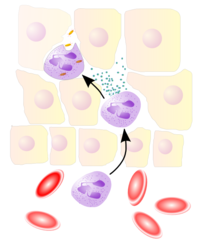Reviewer: S. Randhawa, M.D., Fellow, LSU (Shreveport) Department of Allergy & Immunology
CD45, leukocyte common antigen (LCA), is a type I transmembrane protein present on all hemopoietic cells, except erythrocytes. CD45 is defective in T-B+NK+ SCID.
| Type of cell | CD markers |
| stem cells | CD34+,CD31- |
| all leukocyte groups | CD45+ |
| Granulocyte | CD45+,CD15+ |
| Monocyte | CD45+,CD14+ |
| T lymphocyte | CD45+,CD3+ |
| T helper cell | CD45+,CD3+,CD4+ |
| Cytotoxic T cell | CD45+,CD3+,CD8+ |
| B lymphocyte | CD45+,CD19+ or CD45+,CD20+ |
| Thrombocyte | CD45+,CD61+ |
| Natural killer cell | CD16+,CD56+,CD3- |
Protein tyrosine phosphatase, receptor type, C also known as PTPRC is an enzyme also known as CD45 antigen. CD45 was originally called leukocyte common antigen (LCA).
CD45 is a protein tyrosine phosphatase (PTP) and an essential regulator of T- and B-cell antigen receptor signaling. CD45 suppresses JAK kinases, and thus functions as a regulator of cytokine receptor signaling. CD45 activates various Src family kinases required for the antigen receptor signaling.

Key steps of the JAK-STAT pathway. Image source: Wikpedia, public domain.
Type I cytokine receptors are mediated through JAK/STAT and bind: IL-2, 3, 4, 5, 6, 7, 9, 10, 12, 13, 15, GM-CSF.
The first event following the TCR ligation (binding) is the activation of Src kinases - autoinhibitory loop.
CD45 phosphorylation in TCR signaling is of early and key importance. CD45 and ZAP70 defects cause SCID. ZAP-70 deficiency is a form of SCID with no CD8 cells and no T cell function, but with normal B and NK cells.
Mnemonic
J
JAK3 defect causes a form of SCID.
Janus
"Just fine" B cells (T-/B+/NK-)
This video describes the cellular signaling that takes place with the T cell receptor. This video is from: Janeway's Immunobiology, 7th Edition Murphy, Travers, & Walport. Source: Garland Science.
Various isoforms of CD45 exist:
- CD45RA
- CD45RO
- CD45RB
- CD45RC
- CD45RAB
- CD45RAC
- CD45RBC
- CD45R (ABC)
CD45 is a highly glycosylated and a very long protein.
Naive T lymphocytes express large CD45 isoforms and are usually positive for CD45RA. CD45RA cells contain TRECs. Activated and memory T lymphocytes express the shortest CD45 isoform, CD45RO. CD45RA is large and it shortens as the cell matures.
The cytoplasmic domain of CD45 is one of the largest known and it has an intrinsic phosphatase activity that removes an inhibitory phosphate group on a tyrosine kinase called Lck (in T cells) or Lyn/Fyn/Lck (in B cells) and activates it.
Memory T cells
- Central memory TCM cells express L-selectin and the chemokine receptor CCR7, they secrete IL-2, but not IFNγ or IL-4.
- Effector memory TEM cells produce IFNγ and IL-4.
CD markers for central vs. effector memory T cells:
Central memory T cells: CD45RO+, CCR7+, CD62L+
Effector memory T cells: CD45RO+, CCR7-, CD62L-
Memory B cells have CD27.
CD45 is expressed in lymphomas, B-cell CLL, hairy cell leukemia, and acute nonlymphocytic leukemia.
T and B Cells - Naive and Memory Cell Markers (click to enlarge the image).
CD44
CD44
CD45 - leukocyte common antigen, present on all hemopoietic cells except erythrocytes
CD44 is a cell-surface glycoprotein involved in cell-cell interactions, cell adhesion and migration. PMN adhesion to the endothelium is mediated through CD44.

Neutrophils extravasate from blood vessels to the site of tissue injury or infection during the innate immune response. Image source: Wikipedia, GNU Free Documentation License.
CD44 expression is an indicative marker for effector-memory T-cells.
CD44
CD99
Both participate in leukocyte migration.
What CD marker correlates well with T cell receptor excision circles (TRECs)?
(A) CD19
(B) CD45RO
(C) CD27
(D) CD45RA
(E) CD18
(F) CD15
A: D. Naive T lymphocytes express large CD45 isoforms and are usually positive for CD45RA. CD45RA cells contain TRECs. Activated and memory T lymphocytes express the shortest CD45 isoform, CD45RO. CD45RA is large and it shortens as the cell matures.
Severe combined immunodeficiency (SCID) - 4 groups according to T/B/NK cells (click to enlarge the image).
References
Cluster of differentiation (CD) of leukocytes
CD44, Wikipedia.
PTPRC. Wikipedia.
Memory T cell. Wikipedia.
Published: 05/18/2009
Updated: 08/18/2010
No comments:
Post a Comment